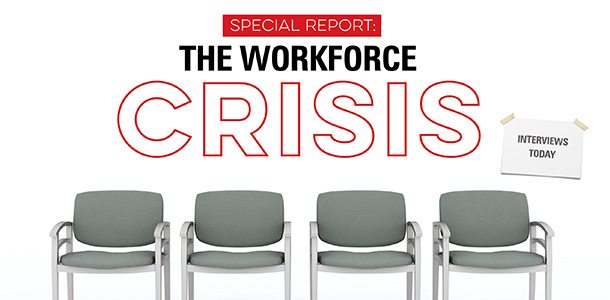The Workforce Crisis: Partnerships with local high schools open industry to new students

As four-year university programs have become the main – if not the sole – focus for high school students’ post-secondary path, marine industry companies are putting themselves in front of those students to introduce them to the opportunities in technical careers.
SeaDek partners with the Melbourne High Business Academy to expose the academy’s students to local manufacturing opportunities. High school sophomores learn about the company, the machines it uses and the careers it offers.
“Manufacturing isn’t really the top of the career list for most students these days. I think people hear that manufacturing is dead in America, and that trickles down to everyone. The kids think ‘Manufacturing is what my grandparents used to do, it’s not necessarily something for me,’” said Jason Gardner, vice president of marketing/advertising at Hyperform Inc.– SeaDek/SwimDek. “But we really show these kids that manufacturing doesn’t have to be this dirty, filthy [job in] this industrial, dark, dingy warehouse. Our manufacturing is relatively high tech.”
After the first year SeaDek hosted the academy, students began interacting with the company on social media and sharing the experience with friends. The next year SeaDek moved from its 17,000-square-foot facility to a new 74,0000-square-foot facility, which showed students the company was growing.

“They were able to see that not only is manufacturing a viable option and not only is manufacturing high-tech and cool, but there’s also growth there,” Gardner said. “I think we’re a good influence and [shining] a positive light on not just U.S. manufacturing, but Florida and regional manufacturing and job growth.”
Gardner is beginning to reach out to local elementary schools as well; the schools offer a Discover Program that highlights people who are doing well and motivated, and Gardner wants to get in front of those students.
“It’s great to get them in high school, but also in high school they’re kind of already on a path. I want to show even younger kids that we’re the kind of country that still makes things,” he said. “The sooner we can start, the sooner we can expose kids to this type of industry, I think the better off we’ll all be.”
Sea Ray participates in Classroom to Careers, a partnership with local high schools to bring students into businesses and expose them to manufacturing career opportunities. The company gives students an overview of the company at the school and buses them to the plant for a tour. Sea Ray has hired employees who are former students of the schools and will choose supervisors and managers who are alumni to lead the tour.
“They could talk about that career path and how they got to where they are. Some of them had gone on to further their education past high school, some of them have not. So we selected those tour guides based on that so the students could really get that real-life [idea],” said Kellie Hood, director of human resources at Sea Ray. “This really happens, it’s not something they can’t really get behind.”
The tour ends with bringing the students on the water to see a finished boat so they can see the end result of all the steps in the tour they attended.
“They were getting off the boat just super excited about, ‘Wow I can’t believe this is what it looks like’ when they saw it coming all the way through assembly,” said Hood. “I think that’s our future employees and we need to engage early to educate them on the opportunities in manufacturing, and this is a great way to do that so that they can learn and make their decisions early and really determine what they want to do.”
Educating students on the opportunities in manufacturing and allowing students to visualize themselves in those careers is much easier when they see someone like themselves at the company. Some of the Melbourne High Business Academy’s former students have been hired at SeaDek, and students who tour the Sea Ray plant have seen recent graduates who they knew working on the plant floor.
“Until you come and visually see it, we can tell you all day long what we do here but it’s amazing once you see what we do,” said Hood. “We had students who actually showed interest in starting their careers here upon graduation.”
Gardner urges other manufacturers to engage in similar programs with local schools to help address workforce shortages to help curb the continuing emphasis on a university track for high school graduates.
“If we want to improve our workforce and the pool that we draw from, and improve our own economy in our own backyards, it’s up to us to get out and do it,” he said.




